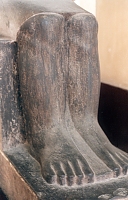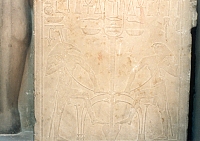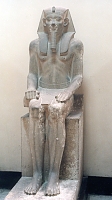

| King Nebhepetre Mentuhotep II painted sandstone Dynasty 11, c. 2061-2010 BCE This portrait sculpture depicts a powerful Middle Kingdom king who reunited Egypt and reigned for 51 years. The sculpture had been ritually buried in his funeral temple at Deir el-Bahri. | ||
| He wears a red crown and the white jubilee mantle. His beard (curled at the end) and his crossed arms allude to conventional depictions of Osirus. Note the oversize legs and feet--indications that this work was designed in a provincial workshop. | 
|

|
| This statue of Sesostris I (or Senusret) is one of ten almost identical sculptures found in his funerary temple. The sculptures are totally traditional royal portraits. The pose is conventional with the right hand holding the folded cloth and the left on the knee. The idealized Sesostris wears the simple kilt, the nemes with the uraeus, and the ceremonial beard. Sides of the thrones are decorated with images representing the union of Upper and Lower Egypt, sometimes the androgynous Nile gods (See also the reliefs at Abu Simbel) and sometimes, as below, depictions of Horus and Seth forming the hieroglyph for union, with the lotus and papyrus representing the south and the north. | ||

|

|
Sesostris I unpainted limestone Dynasty 12, c. 1971-1929 BCE |

|
Statuette of Middle Kingdom man The notes I took in the museum say this is Sesostris III but it certainly doesn't look like other portrait sculptures of him that exist. Please send me an email below if you know the identity of this sculpture. |
|
 Click here to go to the Egypt Index.
Click here to go to the Egypt Index.
 Click here to return to index of art historical sites.
Click here to return to index of art historical sites.
 Click here to return to index of artists and architects.
Click here to return to index of artists and architects.
 Click here to return to chronological index.
Click here to return to chronological index.
 Click here to see the home page of Bluffton College.
Click here to see the home page of Bluffton College.
